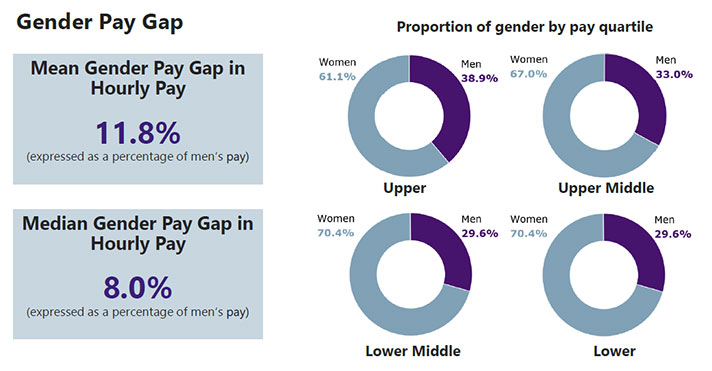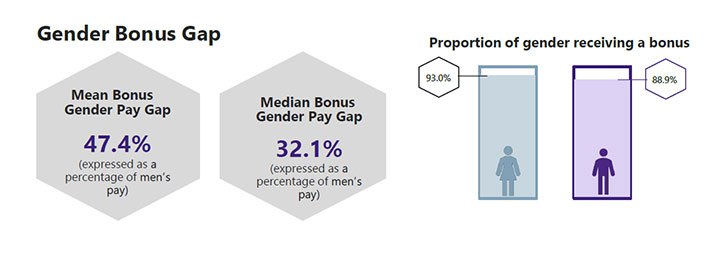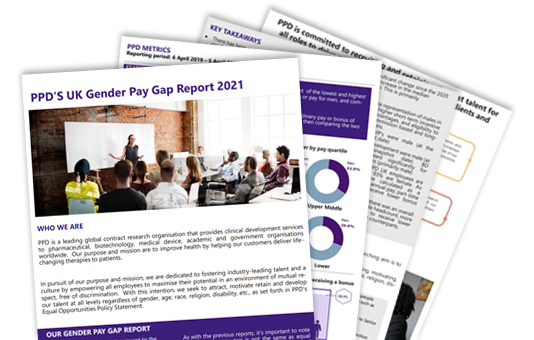
PPD UK 2021 Gender Pay Gap Report
Who we are
PPD is a leading global contract research organisation that provides clinical development services to pharmaceutical, biotechnology, medical device, academic and government organisations worldwide. Our purpose and mission are to improve health by helping our customers deliver life- changing therapies to patients.
In pursuit of our purpose and mission, we are dedicated to fostering industry-leading talent and a culture by empowering all employees to maximise their potential in an environment of mutual re- spect, free of discrimination. With this intention, we seek to attract, motivate retain and develop our talent at all levels regardless of gender, age, race, religion, disability, etc., as set forth in PPD’s Equal Opportunities Policy Statement.
Our gender pay gap report
PPD is publicising this report pursuant to the Equality Act 2010 (Gender Pay Gap Information) Regulations 2017. These regulations require all UK-based employers with 250 or more workers to publish annually specific metrics on their gender pay gap on their company website and the U.K. government website.
The report shows the difference in average pay between women and men, looking at all levels across the company in the U.K. It also examines the distribution of males and females throughout the organisation in terms of pay levels.
As with the previous reports, it’s important to note that a gender pay gap is not the same as equal pay. Equal Pay is the concept of paying men and women equally for equivalent work. A gender pay gap report is not a pay audit and does not report on equal pay as it does not compare pay between men and women for specific roles.
This report also indicates how PPD’s results have changed from the report published in 2020, and provide additional commentary to aid understanding.
PPD metrics
Reporting period: 6 April 2019 – 5 April 2020
Statistics
The median gender pay and bonus gap is calculated by taking the midpoint of the lowest and highest bonus or pay for women and the midpoint of the lowest and highest bonus or pay for men, and comparing the two results.
The mean gender pay and bonus gap is calculated by summing up all the ordinary pay or bonus of women and dividing by the number of women, doing the same for men, and then comparing the two results.


Key takeaways
- There has been a slight decrease in our hourly gender pay gap both on the median and mean relative to the 2020 report, while there was an increase in the median bonus pay gap. The overall company breakdown of males and females has remained static.
- Our pay gap continues, as in previous years, to be influenced by the relatively disproportionate representation of males in roles with highest hourly pay rates.
- PPD’s mean and median gender pay gaps of 11.8% and 8.0% respectively, continue to be lower than the national mean and median hourly gender pay gaps of 14.6% and 15.5%, respectively. They are also substantially lower than the professional, scientific and technical sector (which includes PPD) at 21.7% and 22.4% respectively (according the Office of National Statistics—provisional 2020 data).
- The most significant change since the 2020 report is the increase in the median bonus pay gap. This is primarily attributable to:
- This is primarily due to:
- A disproportionate representation of males in jobs/levels with higher short-term incentive target bonus percentages, and eligibility to participate in commission-based and long-term incentive plans.
- ~73% of VP / SVP’s were male (at the reporting snapshot date)
- ~73% of Business Development were male (at the reporting snapshot date). BD commission increased significantly for several BD employees (primarily male)
- In addition, 18% of PPD UK employees are part-time, of which 93% are female. As bonus payments are calculated as a percentage of eligible annual pay, part-time employees tend to receive lower bonus payments.
- At the more junior levels, there was an overall increase in relevant female headcount, more junior employees tend to receive lower bonuses than their senior counterparts.
Key actions
PPD recognises that there are contributing factors to the gender pay gap, and the overarching aim is to address barriers or biases that may contribute to it.
This goal aligns with the company’s wider global strategy to remain competitive in attracting, motivating, retaining and developing industry-leading talent for all roles regardless of gender, age, race, religion, dis- ability or any other form of discrimination.
PPD will continue to address the gender pay gap through these key initiatives, among others in
PPD actions in 2020:
- Talent management:
- Launched ‘Creating an Inclusive Culture’ workshop for people managers which discusses barriers to inclusion such as gender bias
- Conducted a global talent review to identify PPD’s talent to Senior Director level, with a focus on diversity
- Added two female executive leaders to the executive promotion panel
- Expanded the Women’s Empowerment Network (WEN) from Cambridge to include all UK and Ireland employees
- Launched and promoted the Global Mentoring Programme under the WEN umbrella designed to enhance the careers of female employees. The programme now has 1,000 mentors and mentees
- Analysis:
- Presented UK GPG information to WEN group in 2020, hosted a discussion and invited ideas
- Continued exploring benefits that support working parents
- Reward:
- Launched the Choice Program in response to COVID-19 pandemic- enabling parents to balance work with family commitments, with benefits and bonus protection
PPD is committed to recruiting and retaining the best talent for all roles to drive our performance, deliver for our clients and achieve our purpose and mission.
We confirm that our data has been calculated according to the requirements of the Equality Act 2010 (Gender Pay Gap Information) Regulations 2017
Julia James
General Counsel
